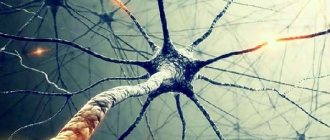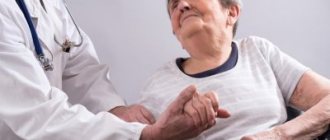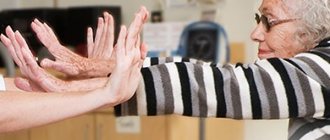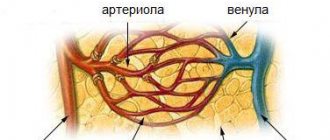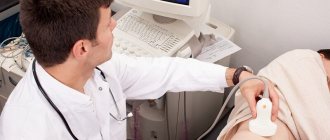Brain dysfunction can have serious consequences. One example is hallucinations in Parkinson's disease. Similar phenomena can develop in 20-60% of people suffering from Parkinson's disease. Most often, hallucinations occur under the influence of external factors, but their source can also be internal.
Thus, the neurodegenerative process that develops in nerve cells involved in the synthesis of dopamine most often leads to psychotic disorders. Taking the medications most commonly prescribed for Parkinson's disease incorrectly can also cause hallucinations.
Psychological consequences of Parkinson's disease
This syndrome is one of the most common diseases of the nervous system. It is named after the English physician, James Parkinson, who first described this type of disorder in 1817. When characterizing the disease, symptoms associated with movement disorders come to the fore. These are slowness (hypokinesia), tremor (shaking), and poor posture.
In addition to increasing physical limitations, the patient's psychological health often suffers. The psychological symptoms of the disease include a depressive state with apathy and a decrease in determination, which is difficult to distinguish from akinesia. Depressed mood is present in 20-40% of patients. In part, psychological symptoms may precede physical ones.
After many years of illness, approximately every fifth patient develops serious signs of mental degradation with impaired concentration and memory, slowed thinking and deteriorating ability to associate.
Hallucination refers to the incorrect perception of a sensory organ without the presence of a real irritating basis from the outside world. For example, non-existent objects may be seen or voices may be heard when no one is speaking. Hallucinations can affect all senses. They are perceived by the person concerned as reality.
The word psychosis refers to a group of mental disorders that affect the ability to meet the normal demands of daily life, significantly interfering with reality. Patients perceive their environment as changed and do not perceive this as the presence of a disease.
CLASSIFICATION
When formulating a diagnosis, the predominant symptom is taken into account. Based on this, several forms are distinguished:
- akinetic-rigid;
- akinetic-rigid-tremor;
- tremulous form (the latter is less common than the others).
The modified Hoehn and Yahr scale is widely used to assess the stages of Parkonson's disease.
(Hoehn&Yahr), which takes into account the prevalence of the process and the severity of manifestations:
- stage 0 – no signs of disease;
- stage 1 – unilateral process (only the limbs are involved);
- stage 1.5 – unilateral process involving the trunk;
- stage 2 – bilateral process without imbalance;
- stage 2.5 – initial manifestations of a bilateral process with mild imbalances (during the push test, the patient takes several steps, but returns to the starting position);
- stage 3 – from initial to moderate manifestations of a bilateral process with postural instability, self-care is preserved, the patient is physically independent;
- stage 4 – severe disability, the ability to stand, walk without support, the ability to walk, elements of self-care are preserved;
- stage 5 – complete disability, helplessness.
Risk factors for psychological side effects
Numerous risk factors contribute to the manifestation of such psychological complications:
- dementia;
- old age;
- duration of the disease;
- concomitant chronic diseases;
- idiopathic Parkinson's disease;
- acute diseases.
The main risk factor is dementia. Approximately 20-40% of patients experience progressive dementia over the course of the disease. The risk of psychological side effects increases with age and duration of illness.
Other risk factors include:
- high doses of drugs;
- change in medications, significant increase in dose, additional introduction of new drugs;
- environmental change, hospitalization;
- dehydration.
Causes
The causes of this disease are the death of neurons in the brain, as a result of which irreversible processes occur and the connection in the construction of movements is disrupted. Gradually, dopamine deficiency and neurotransmitter imbalance arise. But why do the above processes occur? The occurrence of Parkinson's disease has not been fully studied and doctors in some cases can only make assumptions. However, there is a list of factors that in one case or another could become determining in the development of the disease, including:
- hereditary predisposition (of the total number of patients, this disease was inherited in 15%. That is, this category had first-degree relatives who suffered from this disease in old age);
- environmental factor (according to statistics, the disease develops more often in the most economically developed countries, which indicates the influence of environmental pollution on the progression of the disease);
- poisoning with heavy metals (pesticides, cyanides, hexane, hydrogen sulfide, etc.);
- presence of head injuries (especially in older people);
- a history of infectious diseases;
- old age (undoubtedly, in men or women, this disease is more common in old age, however, recently there is evidence of the development of the disease not only in adults, but also in young people under the age of 25).
In addition, doctors came to an interesting conclusion: in their opinion, people whose work involves vibration (builders, drilling rig operator, crane operator, etc.) have attacks of Parkinson’s disease 33% less often than employees of a regular office .
Contents of hallucinations
Hallucinations occur in Parkinson's disease as a side effect of taking the drug and are optical in nature. The patient sees animals, worms, unknown figures, dead relatives. The figures do not speak to the patient.
Sometimes hallucinations of religious content may occur. Some patients experience hallucinations of smell and taste.
Which Parkinson's patients are considered able to work?
In some cases, the ITU does not consider the medical history of patients in order to obtain a disability group. The following persons with Parkinson's disease are classified as able-bodied citizens:
– Early form of the disease with mild symptoms. Persons engaged in physical labor are considered separately and, if they are unable to perform their duties, they are transferred to other work.
– Patients employed based on symptoms of Parkinson’s disease. Among these persons there are those who changed their job profile based on the conclusion of the medical commission.
Occurrence and prevention
Hallucinations in Parkinson's rarely occur out of the blue and develop gradually. Initially, the patient has nightmares. The next step is hallucinations during sleep and upon awakening. After this, they occur during wakefulness. Often at first there is still control over them, the patient knows that the experience does not correspond to reality. Some patients may develop chronic hallucinosis while maintaining control.
When the patient loses the ability to classify symptoms as unreal, a hallucination replaces reality. This affects the patient’s behavior, anxiety and panic develop. Thinking and memory may also be affected. Thus, symptoms of acute psychosis arise.
To prevent these problems, you should not exceed the dose of medications prescribed by your doctor. If possible, try to avoid multiple unnecessary drug combinations. Adequate fluid intake reduces the risk of developing psychosis.
SYMPTOMS
Parkinson's disease usually occurs after 45 years of age, with early onset variants occurring (so-called juvenile parkinsonism). There is no dependence on gender, region of residence, social status, or race.
There are motor and non-motor manifestations of the disease. The development of motor skills is often preceded by depression, sleep and smell disorders, and constipation.
Basic motor signs
Motor manifestations debut
most often with trembling in one hand that is at rest. As Parkinson's disease progresses, the amplitude and frequency increase and the entire hand is involved. Tremor disappears when performing active, purposeful movements and during sleep; intensifies with excitement, physical stress and over time it becomes more and more difficult to hide from others, which often prompts the patient to consult a doctor.
Muscle stiffness
, or rigidity, is determined by the doctor during examination. Patients with parkinsonism experience stiffness and pain in the joints and spine, especially when moving, and a feeling of incomplete muscle relaxation at rest. Before establishing a diagnosis and receiving specific treatment, patients are often unsuccessfully treated for arthrosis and osteochondrosis, which does not bring them relief.
Slowness of movement
(hypokinesia, or bradykinesia) as a sign of Parkinson's disease first manifests itself as difficulty performing precise movements (fastening buttons, tying shoelaces, writing). The handwriting changes, the letters become smaller and become illegible. Gait – slow, mincing, shuffling (the patient almost never lifts his feet off the floor); friendly movements of the arms decrease and then disappear when walking.
Manifestations of hypokinesia are also: hypomimia - mask-like face; rare blinking; quiet, monotonous speech; salivation.
A separate symptom is postural instability (a variant of imbalance). It is detected either during a push test, or is felt by the patient in the form of instability when turning, moving the body, even falling. It usually develops several years after the onset of the disease.
Non-motor manifestations
Psycho-emotional disorders:
- depression;
- apathy (lack of interest, passivity, indifference);
- drowsiness or insomnia;
- disturbances of smell;
- Anhedonia is the absence of pleasure or joy from something.
Autonomic disorders:
- increased salivation;
- greasy skin, sweating;
- constipation;
- urinary disorders;
- orthostatic hypotension.
Question about the ability to work of patients
Parkinson's disease is associated with disability, but only in its later stages. The following patients are considered able to work:
- Patients at the initial stage of the disease. The early stage of Parkinsonism is not characterized by obvious symptoms, so the patient feels quite well and can perform work activities in full.
Attention! If the patient is engaged in heavy physical labor at an enterprise, then his case is considered on an individual basis. As a rule, such workers are transferred to less active activities.
- Patients who got a job in accordance with the conclusion of a medical examination. In this case, even at later stages of the disease, the patient can cope with his responsibilities. The same applies to workers who change their field of activity due to illness.
What do patients look like?
Patients experience motor disturbances, trembling of the limbs, hypokinesia, muscle rigidity and translational instability.
In addition, they experience mental disorders and autonomic dysfunction. The most obvious symptom is trembling of the limbs with a characteristic tremor observed at absolute rest. The frequency of the motor reflex varies from 4 to 6 tremors per second. Sometimes you can observe a head tremor, characterized by nodding, trembling of the lower jaw, eyelids or tongue. Less commonly, trembling covers the entire body.
Strengthening of motor reflexes occurs in stressful situations or even with minor excitement and subsides during sleep. Handwriting becomes small and angular, micrography is observed.
The disease manifests itself in a decrease in spontaneous motor reflexes. A person can freeze in one place and maintain this body position for 30 - 40 minutes, and sometimes longer. Movements become constrained and uncertain, steps are small. When walking, the feet are parallel to each other, the gait is more reminiscent of a doll's. At the same time, the hands tend to take a calm position near the sides; they do not swing.
Facial expressions become tense, signs of anemia appear. Blinking slows down in frequency, and the gaze becomes frozen. Speech is monotonous with a gradual fading effect. When viewed, the forehead remains straight without characteristic wrinkles.
When the disease has passed into the psychosomatic stage, 20% of patients develop unreasonable fear, insomnia, hallucinations, confusion, paranoia with disorientation. They become uninitiative, apathetic and annoying, and often tend to ask the same question several times.
What disability group can a patient count on?
Let's consider the question of what disability group is established for Parkinson's disease. ITU distinguishes three groups:
- Group I. A severe form of the disease, the consequences of which are manifested in severe limitation of movements and asociality. The patient must undergo examination and treatment in a psychiatric institution.
- Group II. Moderate severity of parkinsonism. Impaired motor function seriously affects a person’s life activity; it becomes difficult for him to perform his work duties.
- III group. Moderate form. Motor functions, although limited, still allow for partial working activity.
Sources
- https://NashiNervy.ru/tsentralnaya-nervnaya-sistema/simptomy-i-posledstviya-bolezni-parkinsona.html
- https://www.parkinson-help.ru/stati/invalidnost-parkinsona/
- https://onevrologii.ru/bolezn-parkinsona/invalidnost-pri-bolezni-parkinsona

